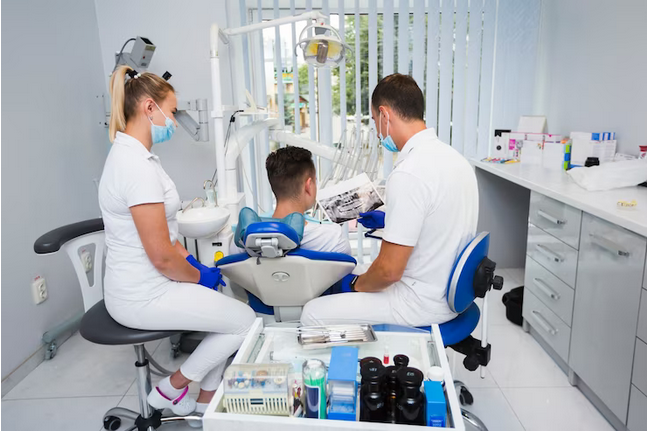Introduction:
Embarking on a dental buildout is a significant undertaking that requires careful planning, attention to detail, and strategic decision-making. The process involves transforming a physical space into an efficient and functional dental practice. This article outlines essential steps for successful dental buildout, emphasizing the key considerations that contribute to creating a thriving dental environment.
Strategic Planning and Design:
The foundation of a successful dental buildout lies in strategic planning and design. Before breaking ground, it's crucial to have a clear vision of the practice layout, workflow, and patient experience. Collaborating with architects and designers specializing in dental offices can help translate ideas into a functional design. Considerations should include the number of treatment rooms, reception area layout, sterilization zones, and compliance with accessibility standards. A well-thought-out design not only enhances efficiency but also contributes to a positive patient experience.
Compliance with Regulatory Standards:
Adherence to regulatory standards is non-negotiable in the healthcare sector, and dental practices are no exception. Before commencing a buildout, it's essential to thoroughly understand and comply with local, state, and federal regulations governing dental facilities. This includes building codes, health and safety regulations, and guidelines for infection control. Engaging with regulatory authorities or hiring professionals with expertise in healthcare compliance can help ensure that the dental practice meets all necessary standards and is ready for operation.
Advanced Technology Integration:
In the modern dental landscape, integrating advanced technology is a key factor in enhancing patient care and optimizing practice operations. Consider incorporating digital imaging systems, intraoral scanners, and electronic health record (EHR) systems into the buildout. Advanced technology not only improves diagnostic capabilities but also streamlines administrative tasks, making the practice more efficient. Investing in state-of-the-art technology during the buildout phase sets the stage for a technologically advanced and competitive dental practice.
Efficient Workflow and Ergonomics:
Efficient workflow and ergonomic design are paramount for a successful dental practice. The layout of treatment rooms, placement of equipment, and organization of workspaces should be carefully planned to facilitate smooth workflow for dental professionals. Consideration of ergonomics is crucial to prevent work-related injuries and ensure the comfort of both dentists and support staff. A well-designed workflow contributes to increased productivity and, ultimately, improved patient care.
Flexibility for Future Growth:
Anticipating future growth and changes in the dental practice is a strategic consideration during the buildout. Designing a space that allows for flexibility and scalability is essential to accommodate potential expansion, changes in technology, or the introduction of new dental services. This foresight not only future-proofs the practice but also minimizes the need for extensive renovations or reconfigurations as the practice evolves.
Cost-effective Material Selection:
Balancing quality with cost-effectiveness in material selection is a critical aspect of a successful dental buildout. Choosing durable and easy-to-maintain materials is essential for long-term sustainability. Consideration should also be given to infection control, as certain materials may be more resistant to microbial growth. Collaborating with experienced contractors and suppliers can help strike the right balance between cost and quality, ensuring that the dental buildout remains within budget without compromising on functionality or aesthetics.
Environmental Sustainability:
Incorporating environmental sustainability into the dental buildout aligns with broader trends in healthcare and contributes to a positive community and professional image. Choosing energy-efficient lighting, eco-friendly building materials, and water-saving fixtures not only reduces the environmental impact but may also lead to cost savings over time. Additionally, incorporating sustainable practices can enhance the overall reputation of the dental practice within the community.
Patient-Centric Design:
A patient-centric design is fundamental to the success of any dental practice. Consider the comfort and experience of patients when planning the layout and aesthetics of the practice. Reception areas should be welcoming, and treatment rooms should be designed for patient comfort and relaxation. Attention to details such as color schemes, lighting, and waiting area amenities contributes to creating a positive and calming atmosphere, fostering patient satisfaction and loyalty.
Comprehensive Staff Training:
Successful implementation of a dental buildout extends beyond the physical space to include comprehensive staff training. All team members should be familiar with the new layout, equipment, and workflows to ensure smooth and efficient operations. Training should encompass emergency protocols, infection control measures, and the use of new technologies. Investing time and resources in staff training during the buildout phase pays dividends in terms of enhanced patient care, improved staff morale, and overall practice success.
Conclusion:
In conclusion, perfecting a dental practice through a successful buildout requires a multifaceted approach encompassing strategic planning, compliance with regulations, integration of advanced technology, efficient workflow design, and a focus on patient satisfaction. Balancing these elements, along with considerations for cost-effectiveness, sustainability, and staff training, sets the foundation for a thriving and competitive dental practice. By meticulously addressing each aspect of the buildout process, dental professionals can create an environment that not only meets current needs but also positions the practice for sustainable growth and success in the ever-evolving landscape of oral healthcare.





Comments